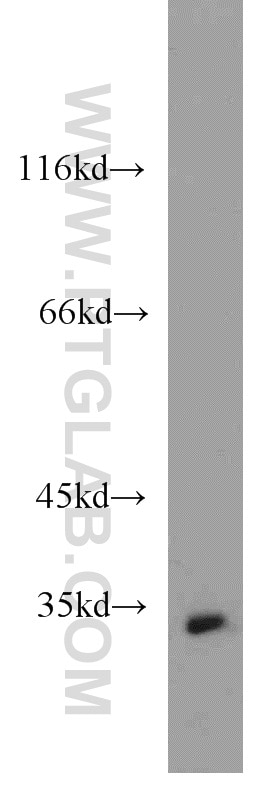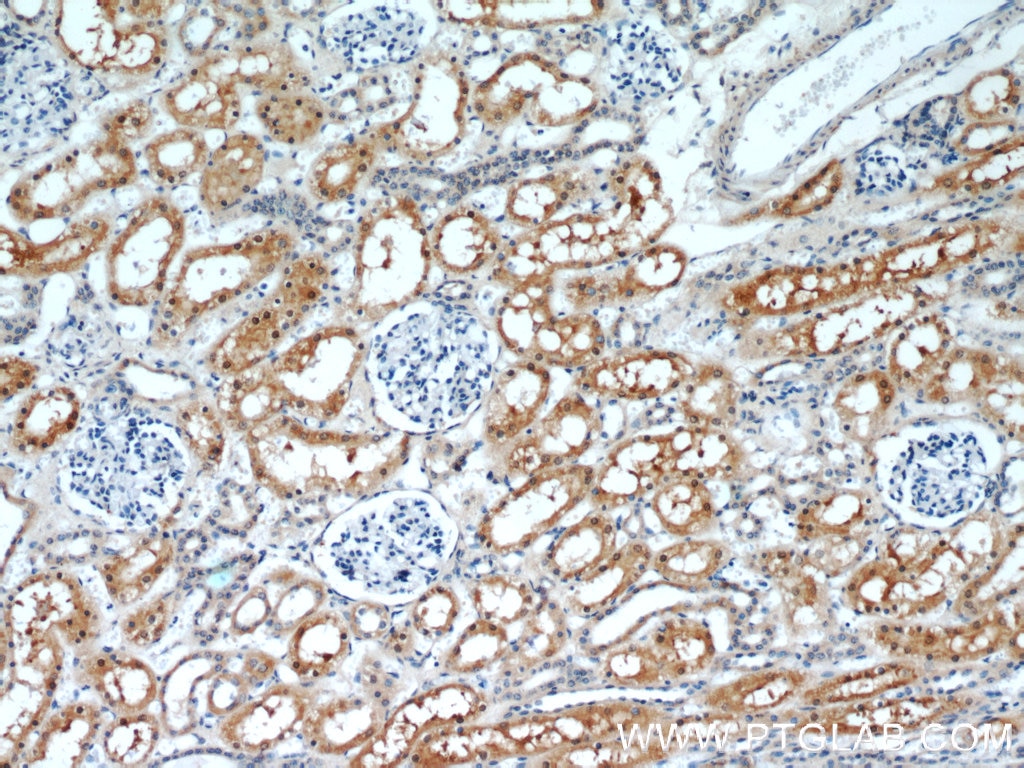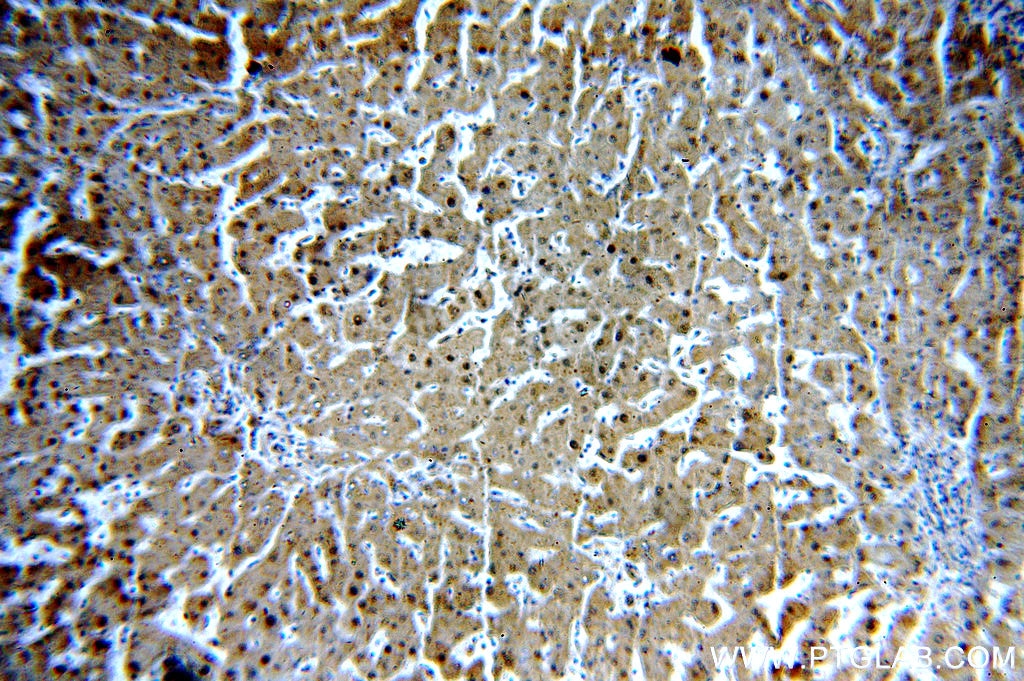Anticorps Polyclonal de lapin anti-RGN/SMP30
RGN/SMP30 Polyclonal Antibody for WB, IP, IHC, ELISA
Hôte / Isotype
Lapin / IgG
Réactivité testée
Humain, rat, souris et plus (1)
Applications
WB, IP, IF, IHC, ELISA
Conjugaison
Non conjugué
N° de cat : 17947-1-AP
Synonymes
Galerie de données de validation
Applications testées
| Résultats positifs en WB | tissu hépatique de souris, tissu d'intestin grêle de souris, tissu hépatique de rat |
| Résultats positifs en IP | tissu hépatique de souris, |
| Résultats positifs en IHC | tissu rénal de rat, tissu de cirrhose hépatique humain, tissu hépatique humain, tissu rénal humain il est suggéré de démasquer l'antigène avec un tampon de TE buffer pH 9.0; (*) À défaut, 'le démasquage de l'antigène peut être 'effectué avec un tampon citrate pH 6,0. |
Dilution recommandée
| Application | Dilution |
|---|---|
| Western Blot (WB) | WB : 1:3000-1:10000 |
| Immunoprécipitation (IP) | IP : 0.5-4.0 ug for 1.0-3.0 mg of total protein lysate |
| Immunohistochimie (IHC) | IHC : 1:50-1:500 |
| It is recommended that this reagent should be titrated in each testing system to obtain optimal results. | |
| Sample-dependent, check data in validation data gallery | |
Applications publiées
| WB | See 10 publications below |
| IHC | See 1 publications below |
| IF | See 1 publications below |
Informations sur le produit
17947-1-AP cible RGN/SMP30 dans les applications de WB, IP, IF, IHC, ELISA et montre une réactivité avec des échantillons Humain, rat, souris
| Réactivité | Humain, rat, souris |
| Réactivité citée | bovin, Humain, souris |
| Hôte / Isotype | Lapin / IgG |
| Clonalité | Polyclonal |
| Type | Anticorps |
| Immunogène | RGN/SMP30 Protéine recombinante Ag12423 |
| Nom complet | regucalcin (senescence marker protein-30) |
| Masse moléculaire calculée | 299 aa, 33 kDa |
| Poids moléculaire observé | 33 kDa, 25 kDa |
| Numéro d’acquisition GenBank | BC073173 |
| Symbole du gène | RGN/SMP30 |
| Identification du gène (NCBI) | 9104 |
| Conjugaison | Non conjugué |
| Forme | Liquide |
| Méthode de purification | Purification par affinité contre l'antigène |
| Tampon de stockage | PBS avec azoture de sodium à 0,02 % et glycérol à 50 % pH 7,3 |
| Conditions de stockage | Stocker à -20°C. Stable pendant un an après l'expédition. L'aliquotage n'est pas nécessaire pour le stockage à -20oC Les 20ul contiennent 0,1% de BSA. |
Informations générales
Regucalcin (RGN), also known as SMP30, is a highly conserved, calcium-binding protein, that is preferentially expressed in the liver and kidney. SMP30 is preferentially localized in hepatocytes and renal proximal tubular epithelial cells. It is known to be related to aging, hepatocyte proliferation and tumorigenesis. It may be useful for HCC serologic screening, especially for the patients with AFP Negative. RGN encodes two isoforms: 33 kDa and 25 kDa.
Protocole
| Product Specific Protocols | |
|---|---|
| WB protocol for RGN/SMP30 antibody 17947-1-AP | Download protocol |
| IHC protocol for RGN/SMP30 antibody 17947-1-AP | Download protocol |
| IP protocol for RGN/SMP30 antibody 17947-1-AP | Download protocol |
| Standard Protocols | |
|---|---|
| Click here to view our Standard Protocols |
Publications
| Species | Application | Title |
|---|---|---|
Transl Lung Cancer Res Senescence marker protein 30 inhibits tumor growth by reducing HDAC4 expression in non-small cell lung cancer. | ||
Ecotoxicol Environ Saf Hexavalent chromium triggers hepatocytes premature senescence via the GATA4/NF-κB signaling pathway mediated by the DNA damage response. | ||
Ecotoxicol Environ Saf Identification and functional analysis of senescence-associated secretory phenotype of premature senescent hepatocytes induced by hexavalent chromium. | ||
J Endocrinol Hepatic thyroid signaling of heat-stressed late pregnant and early lactating cows. | ||
Int Immunopharmacol Senescence marker protein 30 (SMP30) protects against high glucose-induced apoptosis, oxidative stress and inflammatory response in retinal ganglion cells by enhancing Nrf2 activation via regulation of Akt/GSK-3β pathway | ||
Toxicol Lett Dioscin, a natural steroid saponin, shows remarkable protective effect against acetaminophen-induced liver damage in vitro and in vivo. |












